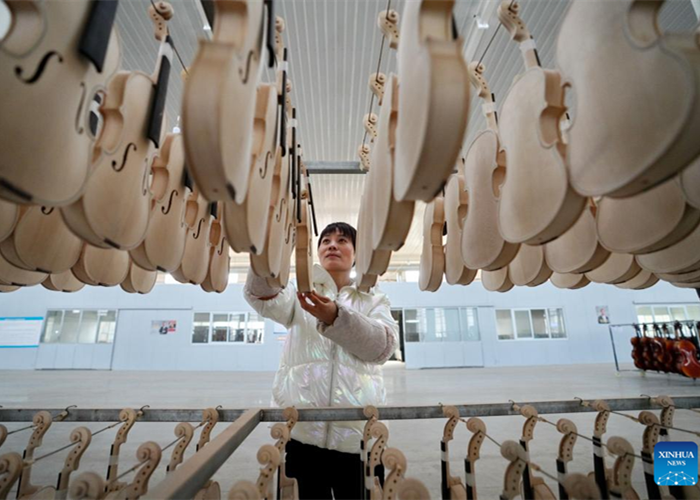Farmers Becoming Artists amid Rural Shandong's Development
Shandong Province is synchronizing poverty alleviation with rural revitalization by introducing high-end talent and developing projects to enrich residents while maintaining a friendly ecological system.
A typical example is Shengshuiyu Town in Jining's Sishui County, which is known as the home of Confucius.
After driving along a mountain road nestled in greenery, visitors arrived at the town's Dongzhongdu Village, where they came upon some youth exercising, drawing landscapes, doing woodwork and working with clay.
"This is really a fantastic place for my students to learn from nature. They learn fast when they get themselves involved," said Hu Jicheng, who led a group of students from Chengzi primary school for field studies.
Last year, by contrast, the village was seldom visited by outsiders. Many houses were dilapidated, and roads were narrow and muddy. Things began changing last year when Shengshuiyu was designated as a demonstration area for the province's rural revitalization campaign.
Since then, local governments have invested in roads, water supplies and a drainage system, as well as computer network systems in the demonstration area that are home to 3,576 families in 18 villages.
After completing the infrastructure, local governments initiated a campaign to woo talent to develop projects in the communities. To date, local governments have signed 30 projects with 37 partners.
"We have changed 48 old, shabby houses that were not being used into places where students and tourists can read, have coffee and tea, work with clay and do woodwork," said Tian Bin, 46, one of the partners.
"The local government has built the platform for us. What we need to do is to develop a rural environment in which people and nature can coexist in harmonious ways."
"Our village is changing every day. The environment is getting better and better, and so are our lives," said Li Baoyu, the Party branch secretary of Dongzhongdu, adding that the projects developed by the partners are bringing more income to the village.
With more tourists coming to the village, restaurants and shops are getting busier, providing jobs for residents.
Kong Deyun, 44, found a satisfactory job at a restaurant.
"It takes me five minutes to walk to the restaurant. I can earn around 2,000 yuan ($287) every month," Kong said, adding that she also sells the fruits and vegetables she grows to the restaurant.
"The price the restaurant offers is usually higher than the market," she said.
Li is especially glad to see so many young people.
"Seeing young people in our village makes me feel confident in our future," he said.
Shandong has been putting efforts into building environmentally friendly rural areas over the years. It has developed 1,500 villages that feature beautiful landscapes and sound living environments by improving infrastructure such as toilets and sewage treatment facilities, according to the provincial Department of Ecology and Environment.
Based on a sustainable ecology, local governments are helping enrich the lives of local farmers.
For example, farmers in Qingzhou, a county-level city of Weifang, Shandong, have a profitable sideline. When free from farm work, they pick up brushes to portray their real lives in rural areas through art.
Wang Huaqin had never thought a farmer like her could earn 400 to 500 yuan a day by painting. The 49-year-old has become a skilled painter, though she started learning just four years ago.
Several of her paintings have won prizes in provincial and national competitions, and one of her works is the first of the farmers' paintings in Qingzhou to have been displayed in the National Art Museum of China.
In 2017, she established a painting studio and has helped more than 70 farmers learn painting. Each of them can earn as much as 70,000 to 80,000 yuan every year. Wang and her team also dabbled in commercial wall paintings.
"We have been invited to draw on the walls in Qingdao and cities in Hebei Province," Wang said.
"Each of our farmers can earn more than 10,000 yuan per month when business is good," she told a media tour on July 21.
There are more than 30,000 farmer-painters like Wang in Qingzhou. Every year, they create 500,000 paintings with total revenues reaching 300 million yuan, thanks to the local government efforts to extend the industrial chain of farmer paintings and combine it with tourism.
A farmer-painter with a medium skill level or above can earn an additional 20,000 yuan annually, the local government said.
"What we are portraying are the most common activities in our everyday lives-stories happening nearby, harvest scenes and places where we live and work," said 74-year-old Ma Jiqing, a locally prominent painter who has been involved in the arts for more than 60 years.
Ma is a heritage successor of the Qingzhou farmer-artists. His work has become an essential part of his family life, persuading fellow villagers to learn.
The local government has been making great efforts to encourage the development of farmer-painters in a bid to boost tourism sectors and rural revitalization, said Chen Tongzhou, head of the Qingzhou publicity department.
By 2023, Qingzhou is expected to have more than 100 painting studios, 100 rural cooperatives and 100 online companies selling farmers' paintings, Chen added.
(Source: China Daily)
Please understand that womenofchina.cn,a non-profit, information-communication website, cannot reach every writer before using articles and images. For copyright issues, please contact us by emailing: website@womenofchina.cn. The articles published and opinions expressed on this website represent the opinions of writers and are not necessarily shared by womenofchina.cn.








 WeChat
WeChat Weibo
Weibo 京公网安备 11010102004314号
京公网安备 11010102004314号